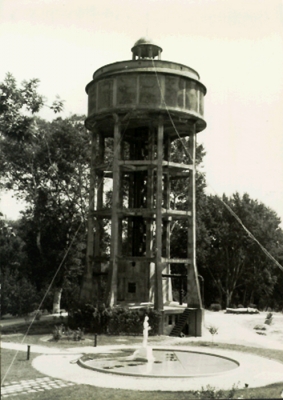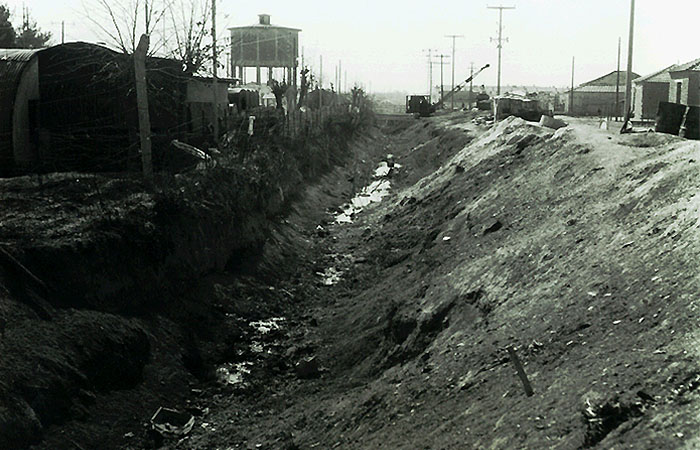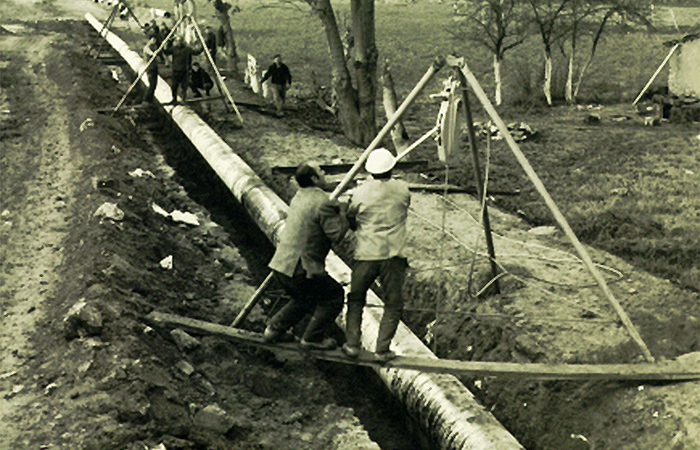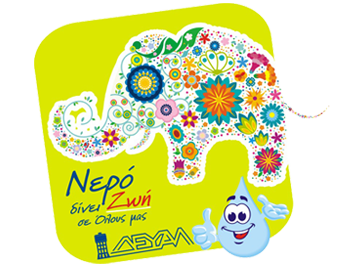The history of DEYAL
«YESTERDAY AND TODAY»
The history and current presence of DEYAL at the service of the sectors of water supply, sewerage and environment in the city of Larissa is based on a long-term course, starting from the beginning of the previous century.
During this course, the problems that occurred from the very first time until currently were many but the Company managed to handle them all. The Company, regardless of the legal form it had every time- responded to its mission and justified its presence in the relevant sectors-competences, and literally created civilization by upgrading the quality of life of our city's inhabitants.



For thousands of years now, the history of Larissa, thanks to the location of the city near the river of Pinios, has been linked to the river, especially regarding water supply and defense
Thousands of years ago, the first inhabitants, Pelasgi, carried water from Pinios inside leather sacs and clay jars. The excavations revealed old aqueducts in many parts under the ground of Larissa, allowing us to assume that the ancient city had a water supply network, but it cannot be determined how the water was distributed. According to tradition, Larissa received water from the springs of Kranon. If this is true, then it means that the inhabitants had to opt for this solution when they probably discovered that the free water of Pinios cost a high price in human lives, because it spread contagious diseases that resulted in the death of many people.
It seems that the artificial aqueducts of the Macedonian, and especially the Roman period were the successors of the above method. During the Byzantine Times and the Occupation by the Franks, Larissa used ΄"water canals"΄. The peripheral ditch of Larissa that exists until today was constructed during the Occupation by the Francs. During the Turkish Occupation there was an attempt to improve the water supply network of the city. But in all cases, in all centuries, the water has always been rare for Larissa and unhealthy.
Timeline
1881: Larissa – that looks like a Turkish village- is liberated from the Turks. The inhabitants strived to recover and modernize the city.
1882: The First "City Plan" is elaborated and was enforced in 1886.
1890: The law DOX was voted for "water supply" to Larissa. The Municipality awarded the project to the engineer P. Protopapadakis (who later became Prime Minister of Greece) but he abandoned the project because he was unable to carry the burden of the financial cost.
1903: The Municipality had always been interesting in the "Miraculous Electric Lighting" as they used to call it, and in water supply.
The Municipality bought the study of the site engineer Ioannis Govaris regarding the construction of a hydroelectric project at Vernezi of Pinios.
The project was never accomplished, due to the huge, for that time, cost (5 million golden francs).
1909: The City Council (Mayor Ach. Asteriadis) signs a contract with the "Pinios" group of companies for the construction of electric lighting and water supply projects, including their exploitation for a period of 50 years.
With the Municipality's consent, "Pinios" sold the concessions to the French company "OMNIUM".
In the mean time, the method with which Larissa was supplied with water supply in the early 20th century was not very different than the one Pelasgi used 4000 thousand years ago, namely an unhealthy way which had become an everyday problem. This method was as follows: The water was taken from the part of the river that entered the city and from the central current, in order to be as clean as possible. On the riverbed there were many branches and smaller currents with mostly dirty waters, especially in summer, when the children entered the waters or when the river was full of frogs.
In case there was a high demand for water, the water-sellers took it from anywhere they could. For the easier transportation of the water, stone paved platforms, referred to as "stairs", had been constructed since the middle ages at three points in the city. These platforms were 8-10 meters wide and entered into the bed, until the main axis of the river, in order to make water supply possible even when the water level was minimum. Later they used pumps that pumped water from Pinios via pipes.
Next, the water that was taken in this way was loaded inside leather sacs with a capacity of 40-50 kilos. Animals carried the sacs to the neighborhoods of the city. The water sellers touted the water just like the other sellers touted their merchandise. They were referred to as water carriers or sac-carriers, because they were selling water inside sacs. Later, the water was transported inside small tuns or barrels made of zinc and hauled by horse-carts. The quality of the water that the people of Larissa used to buy at that time is evident by the following: the sac sellers had to put at the orifices of the sacs a bunch of leaves or plants, that would serve like filters and would withhold sand and other foreign matters. It is evident, though, that only the river frogs would be stopped by this primitive filter, while other impurities and bacteria could pass unobstructed.
Also, the sac sellers had to wash the sacs frequently, to remove any sand and foreign matters that the water might have left inside. But the sac sellers believed that these primary measures were needless and so the water bacteria were always...safe. The sac sellers had been organized as a professional class and they had gained privileges, such as occupational tax exception etc.. They had also acquired some power. They were obliged to take part in fire extinguishments, by carrying water. The water supplied in this way in Larissa could not be used immediately. People had to put it inside big jars and then to put the jars in the ground up to the neck, in order for the water to remain cool in summer and not to frost in winter. After a couple of days, the sand and the other foreign matters that made the water reddish or muddy settled. At the same time, people poured some alum, hoping to sterilize the water, something that was delusional. In order to give an idea about the quality of water, we can only say that the sewers of the prison which was located at the southwest corner of the fortress were drained near the bridge of Alkaza, where the sac carriers took the water, while the waste from the factory and from the settlements near Pinios were drained a little further. One can see that under these circumstances, the people of Larissa were unable to satisfy their thirst during summer without feeling some kind of disgust every time they drank water. The use of water for purposes of bathing, cleaning, watering and other needs that were stronger during the hot summer in Larissa, was always limited. We must also note that in many houses there were wells, but their water was not potable, because due to the lack of sewers in the city, the wells were contaminated by the drainage of the cesspits.
1913-1914: "OMNIUM" commences the works in 1913 and installs machines of 220 Volt DC. The next year, the city center, public and private shops and many houses were electrically lighted. The projects for the electric lighting of the settlements and for the water supply projects were interrupted in 1914 because of the First World War.
1918: After the end of the war, the company does not continue the works, abandons every attempt for water supply and provides quite poor lighting.
The Municipal authorities and the committee of occupational organizations start a tremendous effort to dismiss "OMNIUM", since the company does not fulfill its obligations.
1924: On 20 October 1924, the City Council unanimously declares "OMNIUM" in default and interrupts every relationship with the company, for breaching the contractual terms.
But the worst of all is that the people of Larissa paid a high price for this water supply method. Abdominal typhus, dysentery, paratyphuses and other intestinal diseases were typical in Larissa and every family had suffered at least once, while there were also many deaths. According to the data of the health services, during the decades 1920-1930, 1038 of the 23,000 inhabitants of Larissa died of such diseases. There was a funeral every three days due to the poor water supply. This is the main reason why the newly founded water supply and electric lighting company, that electrified the city no sooner than 1925, decided to try on the same year to solve the water supply problem by making every possible effort.
1925: A financial body is formed, in order to undertake the project of electric lighting and water supply. This was the "Larissaiki Water Supply and Electric Lighting Company" but immediately –for legal reasons- it was renamed to "Water Supply and Electric Lighting Company of Larissa" or EYHL.
On 22 August 1925, the EYHL memorandum of association was published in the Official Government Gazette. EYHL would have for 30 years the relevant concessions for water supply and electric lighting and the contribution of the Municipality would be 76% (1926).
In progress, EYHL managed to surpass every obstacle and Larissa was electrically lighted in June 1925.
EYHL surpasses all problems (financial, technical know-how, projects, etc.) and ensures the electrification of the city thanks to the decisiveness of its leaderships, the diligent work of the factory staff and the support of the people of Larissa.
(EYHL quadruplicated the current production within five years: From 183,500 kwh in 1926 to 740,000 kwh in 1930.
1925-1926: As soon as EYHL ensured the electrification of the city, the company proceeded immediately to the water supply. EYHL awarded the elaboration of a study and also asked from the Municipality to contribute to the project.
On 21 December 1925, the then mayor Mich. Sapkas introduced the water supply issue of EYHL to the first City Council.
The reactions were strong and variable because, even if this seems strange today, the implementation of a water supply system would affect many interests. Many persons had interests and wanted to preserve them, even if this meant that their fellow citizens would suffer from diseases and some of them would even die.
What's most important is that the water supply system would make useless the "water carriers" or "sac carriers" who were an organized union with many privileges.
On 23 February 1926, the decision of the City Council of Larissa enabled the implementation of the water supply system.
1927: The first works for water supply commence in Larissa, a city of 24,000 inhabitants. The works will be completed on 1930.
The cost of the water supply projects was 20,000,000 drachmas, a huge amount for that time.
1930: All water supply projects are inaugurated in a festive ceremony.
The prime minister, Eleftherios Venizelos attended the inauguration, since the modernized water supply of the city had become a major event. Venizelos pushed a button and immediately homes and shops had running water.
Now the people of Larissa could enjoy sterile and healthy water, of top quality and, most of all, plenty.
By a simple turning of the faucet, the housewives –who had suffered a lot from the water famine and the cruelty of the "sac carriers"- had now as much water as they wished, both to drink and to do cleaning works.
The torment of the lack of water and the problem of typhus were now only a bad memory.
And as the Mayor, Mich. Sapkas said during the inauguration ceremony, the whole cost of the water supply project (20 billion GRD) was covered by the inhabitants and the state did not have to pay a dime.
Venizelos heard this statement and kept it in his mind. After the inauguration, he gathered the Athenian journalists who had accompanied him in Larissa and stated:
"Please write in your newspapers that the projects for the water supply and electric lighting of Larissa were completed thanks to the financial contributions of the city, by virtue of an unusual law induced by the Municipality of Larissa, and invite all Mayors of all Greek cities to follow the example of Larissa regarding the execution of municipal works".
To the general surprise of Greeceand in the middle of the worst financial crisis that had afflicted both Greece and the whole world, EYHL succeeds in 1930 to make the dream of dozens of generations come true by ensuring water supply in Larissa. And this was accomplished in the most optimum way, better than any other Greek city, including the capital. Because ever since, the company supplies the city with plenty, cheap and healthy water for all inhabitants and on a 24-hour basis. The accomplishment of this solution required a long, hard and complex effort, through which new personalities of the city rose to prominence, such as Michalis Sapkas, Nikolaos Filios, Michalis Bouras, Demetrios Hatziyannis, Zenophon Rizopoulos, Elias Frytzalas and many more, originating from various political sides and social classes, but they all shared one common characteristic, the ability to set aside the petty party-spirited and personal ambitions and to cooperate all together for the best interest of their community.
1940: EYHL continued its course as a local utility Self-Administrated Organization. Within ten years (1930-1940) it doubled the consumption of electricity and multiplied the water per inhabitant. Larissa had the highest consumption per inhabitant in provincial Greece, regarding both electricity and water.
In 1938 the company's capital was 21,5 million GRD; 66,000 shares (76.4%) belonged to the Municipality and 19,170 shares (23.6%) belonged to private shareholders.
By virtue of the Emergency Law of 10 August 1940, the EYHL memorandum was amended and the company was renamed to "Larissa Organization of Water Supply and Electric Lighting" (OYHL).
1940-1950: During the war, due to bombardments and earthquakes, OYHL suffered serious damages in water meters and the water tower cracked.
During the Occupation by the Germans and the Italians, the administration of the Organization was oriented into three main efforts.
- Supply of current and water for the inhabitants
- Survival of the staff and their families
- Maintenance of machines and networks. In 1945, the total damages of OYHL during the war were estimated in 14 billion GRD, a huge amount for that time. In reality, the damages were much higher.
After the liberation, OYHL proceeded headlong to the reconstitution that led to its profitable (since 1946) operation.
The rapid reconstitution of OYHL allowed the organization to respond to the highly increased demands of the city and to assist in the further development of Larissa. As a result, the organization became a major operator for the progress and advancement of Larissa. This new era, which is the peak of OYHL's operation, is linked to the rapid development of the Larissa. During the census of 1940, the city had a population of 35,000 inhabitants. In 1945 there were 31,000 food coupons in Larissa, showing that the population was not higher than 30,000 inhabitants. In 1946, after the commencement of the internal events in Greece and the afflux of the country inhabitants in the cities, the population of Larissa started to increase and in 1950 it reached the number of 41,016 inhabitants.
1950-1960: During this decade, the rapid development brought strong differentiations in the financial and social life of the city and of the whole region.
When peace was restored to the country, around 1950, Larissa's population started to increase at an unprecedented pace. Farmers from various parts of the plain and of the mountain areas of the Prefecture of Larissaleave their villages and come to Larissa. It is estimated that in 1956 the population of Larissa was more than 60,000 and this number was doubled within only ten years. This increase resulted in the establishment of new settlements, in all directions of the city. The expansion was such, that areas once considered as fields, were turned into land plots and acquired settlements. OYHL had to ensure water and lighting for all these people. OYHL did not only ensured the required quantity of water, but it supplied water on favorable terms. It is evident that in order for OYHL to be able to respond to the demand for water, it had to proceed to bold extensions of the water supply networks and to the establishment of a new refinery that was inaugurated on 17 September 1956 during a festive ceremony. Note also that the OYHL staff constructed both the extensions and the premises of the refinery.
This development is followed by the water supply and electric lighting activities of OYHL.
OYHL, properly prepared, supplies plenty of water and current, while it continues to extend the networks, in order to ensure the necessary infrastructure for the further development of Larissa.
For OYHL to be able to deliver such a beneficial and dynamic project, many agents assisted and first of all the specialized in the various tasks personnel, as well as the administrations, with their organizing and management skills and their perspicacity.
OYHL also offered indirect services for the beautification and development of Larissa.
He constructed the elegant small temple of Saint Vissarion at the square Odeio. The icons of the church were painted by Ag. Asteriadis (1954).
A concert hall in the Municipal Conservatory.
A fountain at the square of Tahydromeio.
A three-storey stone guesthouse in Platamonas, with 22 apartments, as an accommodation for the summer vacations of the personnel (1955).
The erection of the MetropolitanTemple was accomplished with money gathered from charges that were imposed on the consumers.
In 1960, the Public Power Corporation (DEH) bought out from OYHL the concession on current, the mechanical installations with the network and also hired the personnel of OYHL.
1960-1980: This decade, which was characterized by rural depopulation, multiplies the water supply needs of Larissa.
The City Council started frequent discussions on making OYHL public. The concession of the Organization on the water supply of Larissa had ended on 1956, but it was extended by virtue of several decrees until 15-1-74.
On 17-12-73 the City Council decided that OYHL would operate as a "Municipal Water Supply Company of Larissa" and this is how DEYL emerged.
Therefore, a social utility organization that had been created by the people of Larissa lost its legal form, but it could still provide services to all the inhabitants of Larissa.
An important capital of the history of the water supply of Larissa closed when OYHL became a Public company and was renamed to DEYL. Forty-eight years after the establishment of OYHL and 44 years after the inauguration of the water tower and of the internal water supply network, at a time when Larissa was still under rapid development, the Municipality undertakes the administration of the Organization and the responsibility to ensure plenty, clear and cheap water for the people of Larissa.
On 25-1-77 the City Council unanimously decided to add the sector of sewerage to DELYAL as a second scope. Thus DEYL is renamed to DEYAL.
The purpose of the new sector was the construction of sewerage projects, their maintenance, and the optimum exploitation of the already existing and under construction networks.
1980-2000: The last twenty years were perhaps the most important period for the water supply of Larissa. The target of DEYAL is to ensure plenty and healthy water for a city where the demands keep on growing every day.
Pinios could no longer be the only water supply source, since everyday it becomes more and more polluted and the quantity of water keeps on lessening.
DEYAL starts to seek new water supply sources.
The water that was brought to the surface by the bores that had been opened in the past was not suitable for drinking.
In 1981 DEYAL acquires its current form and falls under the provisions of L. 1069/80 "on incentives for the establishment of Water Supply-Sewerage Companies".
According to the P.D. 379/10-4-81, DEYAL is a legal person governed by private law, with social utility character and its scope is water supply and sewerage.
DEYAL is governed by the provisions of L. 1069/80 regarding issues of administration, operation, organization and maintenance of its projects, as well as regarding its funding sources.
In 1986 the excavation of a series of bores started in the area of Yannouli.
These bores supplied Larissa with approx.65% of the total water that the city needed. Still, a 35% from the river water was needed. In September 1988, Pinios run literally dry. Larissa spent almost 60 hours without regular water supply.
After several pressures on behalf of DEYAL, the city approved the funding of a new series of bores in the area of Abelonas.
The works for the bores and the pipeline were implemented in no time (March0June 1989) and Larissa could now receive all the water it needed from the bores at a percentage of 100%.
Therefore, since 1990, the people of Larissa have stopped drinking from Pinios, since the quality of the river's water was poor and the quantity was inadequate, especially during summer.
The works for the bores and for the water pipeline in Platanoulias were implemented in 2000 and covered all the needs of the city.
Currently the water is supplied to Larissa from a total of 17 bores (5 in Yannouli, 7 in Abelonas and 5 in Platanoulia).
Thanks to the existing and future bores and projects, Larissa will have an adequate water supply for at least 20 years.
Landmarks in the history of Larissa regarding water supply and, later, sewerage
Inauguration of the first water supply projects (1930)
Establishment of OYHL (1940)
The Water Supply Organization becomes public and is renamed to DEYL (1974)
DEYL is renamed to DEYAL (1977)
DEYAL falls under the provisions of L. 1069/80
The water supplied to Larissa comes exclusively from the bores (1990)
The water is supplied to the city from the new reservoirs in Mezourlos and Agia Paraskevi (not from the water tower) (2000)





